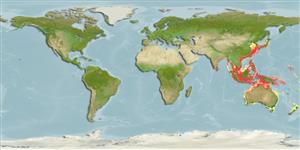Asteroidea |
Paxillosida |
Astropectinidae
Environment: milieu / climate zone / depth range / distribution range
Ecology
Benthic; depth range 2 - 195 m (Ref. 81020). Subtropical
Indo-West Pacific: Bay of Bengal, Japan to the Philippines.
Length at first maturity / Size / Weight / Age
Maturity: Lm ? range ? - ? cm
Life cycle and mating behavior
Maturity | Reproduction | Spawning | Eggs | Fecundity | Larvae
Members of the class Asteroidea exhibit both asexual (regeneration and clonal) and sexual (gonochoric) means of reproduction. Life cycle: Embryos hatch into planktonic larvae and later metamorphose into pentamorous juveniles which develop into young sea stars with stubby arms.
Chao, S.-M. 2000 New records of sea stars (Asteroidea: Echinodermata) from the continental shelf of Taiwan. Zoological Studies 39(3):275-284. (Ref. 77937)
IUCN Red List Status
(Ref. 130435: Version 2025-1)
CITES status (Ref. 108899)
Not Evaluated
Not Evaluated
Threat to humans
Human uses
| FishSource |
Tools
More information
Trophic EcologyFood items (preys)
Diet composition
Food consumption
Predators
Population dynamicsGrowth
Max. ages / sizes
Length-weight rel.
Length-length rel.
Length-frequencies
Mass conversion
Abundance
Life cycleReproductionMaturityFecunditySpawningEggsEgg developmentLarvae PhysiologyOxygen consumption
Human RelatedStamps, coins, misc.
Internet sources
Estimates based on models
Preferred temperature
(Ref.
115969): 17.5 - 28.4, mean 27.2 (based on 973 cells).
